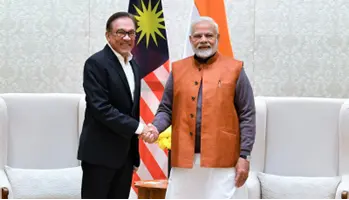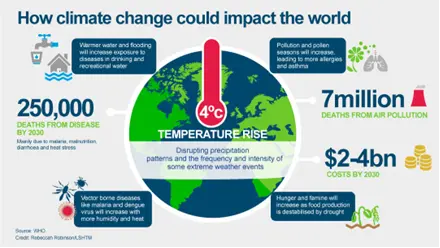Wednesday, 21st August 2024
India’s Nuclear Doctrine Still Remains Relevant
Why in the news?
- In 1998, following the Pokhran II nuclear tests, India established its nuclear doctrine to assert its status as a nuclear weapons state.
- On August 17, 1999, a draft of this doctrine was presented by the National Security Advisory Board, chaired by K. Subrahmanyam, to the National Security Advisor.
- This doctrine remains a key element of India’s strategic posture even after 25 years, reflecting its continued relevance amidst evolving security dynamics.
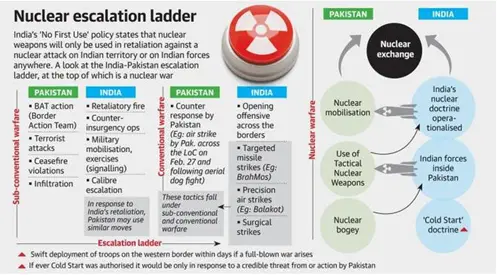
Historical Context and Core Principles:
- India’s Nuclear Milestone:
- The Pokhran II tests in May 1998 marked India's entry into the nuclear weapons club and demonstrated its capability to defend its sovereignty against regional threats, particularly from Pakistan and China.
- These tests were both a display of technological prowess and a strategic signal to neighbouring countries.
- International Response and Doctrine Necessity:
- India faced scepticism from the global community, especially Western powers, prompting the need for a clear nuclear doctrine to prevent an arms race in South Asia and to assert its right to self-defence.
- The draft doctrine was developed to address these concerns and provide a responsible framework for India’s nuclear policy.
Analysis of India’s Draft Nuclear Doctrine
- Transparency and Democratic Values:
- The draft, presented on August 17, 1999, was one of the few instances where a nuclear state publicly shared its nuclear strategy before finalising it, reflecting a commitment to transparency and democratic engagement.
- The public presentation aimed to foster thorough debate and understanding, both domestically and internationally.
- Nuclear Weapons as Political Tools:
- The doctrine conceptualised nuclear weapons primarily as political instruments for deterrence rather than tools for actual combat.
- It emphasised maintaining a credible minimum deterrent to inflict unacceptable damage on any adversary in the event of a nuclear attack.
- No-First Use (NFU) Policy:
- India’s NFU policy states that India will not initiate a nuclear strike but will respond with a massive retaliatory strike if attacked with nuclear weapons.
- This policy underscores India’s strategic culture of restraint and positions it as a responsible nuclear power.
- Diverse and Flexible Nuclear Force:
- The doctrine called for a nuclear force that is effective, enduring, diverse, and flexible, designed to survive a first strike and ensure credible retaliation.
- It emphasised a mix of delivery systems—land-based, air, and sea-based—to maintain deterrent credibility.
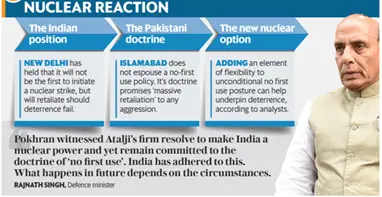
Evolving Threat Landscape:
- Changing Security Environment:
- Since the doctrine’s conception, Pakistan’s full-spectrum deterrence and China’s expanding nuclear capabilities have introduced new complexities.
- The rise of cross-border terrorism and China’s assertive behaviour present ongoing challenges for India’s strategic posture.
Criticisms and Necessity of Core Principles
- No-First-Use Policy Debate:
- Critics argue that the NFU policy is overly reactive and may cede strategic initiative to adversaries. Some suggest adopting a first-use strategy or maintaining strategic ambiguity.
- However, a first-use policy would require a sophisticated arsenal and could increase the risk of escalation and miscalculation, leading to potentially catastrophic outcomes.
- Tactical Nuclear Weapons Debate:
- There is debate over the potential use of tactical nuclear weapons for deterrence. However, the concept of limited destruction is contentious, as even tactical use could escalate into full-scale nuclear conflict.
Way Forward
- Enhancing Survivability and Resilience:
- Technological advancements by adversaries, such as improved conventional delivery systems and cyber capabilities, necessitate updates to India’s nuclear strategy.
- While these challenges require adjustments in numbers and command structures, they do not undermine the core principles of India’s doctrine, which focuses on maintaining a credible second-strike capability.
Conclusion
Despite changes in the security environment and technological advancements, India’s nuclear doctrine remains a cornerstone of stability. It provides a balanced and responsible approach to nuclear deterrence, contrasting with the aggressive strategies of some adversaries.
Source: IE
A ground plan for sustainable mass employment
Why in the news?
- The ambitious ₹2 lakh crore employment package aims to create 4.1 crore jobs, despite this goal, evidence indicates that low wages and short-term skill programs are detrimental to its long-term sustainability.
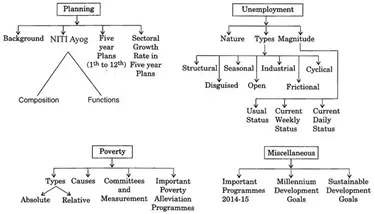
Low Wages and Short-Term Skill Programs Hinder Long-Term Sustainability:
- Economic Insecurity Due to Low Wages:
- Low wages result in economic insecurity for workers, complicating their ability to cover basic needs.
- For example, in the garment industry, there is a 48.5% disparity between minimum wages and living wages in major garment-producing countries.
- Short-Term Skill Programs and Employability:
- In India, 75% of technical graduates and 90% of other graduates are deemed unemployable due to insufficient practical skills and experience sought by employers.
- Stagnation of Workforce Productivity:
- Low wages provide minimal incentive for workers to improve their skills or productivity.
- This stagnation hampers both individual career advancement and overall economic growth.
- Limited Investment in Long-Term Skill Development:
- Only 15% of individuals trained under the Pradhan Mantri Kaushal Vikas Yojana (PMKVY) secured jobs, highlighting the ineffectiveness of short-term training programs in achieving sustainable employment outcomes.
- Perpetuation of Poverty and Inequality:
- The combination of low wages and inadequate skill development perpetuates poverty and inequality. Currently, 42% of the global workforce is engaged in vulnerable employment.
12-Point Policy Initiatives for Sustainable Mass Employment:
- Identify Skill Needs: Develop a register of individuals seeking employment/self-employment and create a tailored plan for each youth in collaboration with professionals at the cluster level.
- Local-Level Initiatives: Integrate initiatives for education, health, skills, nutrition, livelihoods, and employment at the local government level with women’s collectives to ensure community accountability and effective outcomes.
- Vocational Programs: Introduce need-based vocational courses and certificate programs alongside undergraduate programs in every college to enhance employability.
- International Benchmark for Healthcare: Standardise nursing and allied health-care professional courses to meet international benchmarks and address the demand for skilled professionals.
- Women’s Security: Establish community cadres of caregivers to operate crèches universally, enabling women to work without concerns for their children’s safety.
- Invest in Skill Development: Enhance investment in ITIs and polytechnics as hubs for skill development, focusing on states and districts with minimal vocational education infrastructure.
- Startup Skills in High Schools: Incorporate enterprise and startup skills training through professionals in high schools to equip students with practical skills.
- Industry Apprenticeship Programs: Implement a co-sharing model for apprenticeships that combines practical job training with study, ensuring industry involvement in the apprenticeship program.
- Youth Absorption in the Workplace: Scaled apprenticeships can facilitate youth absorption into the workforce, with the government providing employer subsidies conditional on dignified wages upon successful apprenticeship completion.
- Capital Loans for Women: Streamline working capital loans for women-led and first-generation enterprises to support their scaling efforts.
- Skill Accreditation Program: Launch a universal skill accreditation program for skill-providing institutions, with candidates co-sponsored by the state and employers.
- Fund Allocation in Water-Scarce Blocks: Allocate 70% of MGNREGA funds to 2,500 water-scarce blocks and blocks with high deprivation, focusing on the poorest 20 families and enhancing skills for higher productivity.
Way Forward:
- Strengthen Industry-Academia Linkages: Improve collaboration between educational institutions, industry, and vocational training centres to align curriculum with industry needs, ensuring employability through internships, apprenticeships, and job placements.
- Focus on Inclusive Skill Development: Invest in underdeveloped regions and marginalised groups by expanding access to quality education, vocational training, and entrepreneurship opportunities, particularly for women and youth, to address the skill gap and promote economic inclusion.
Source: TH
Climate Change Impact on Panama Canal
Why in the news?
- The Panama Canal, a crucial global shipping route, faces significant challenges due to prolonged drought conditions exacerbated by climate change.
- This has led to decreased water levels in Lake Gatun, prompting discussions about long-term strategies to maintain the canal’s operations.
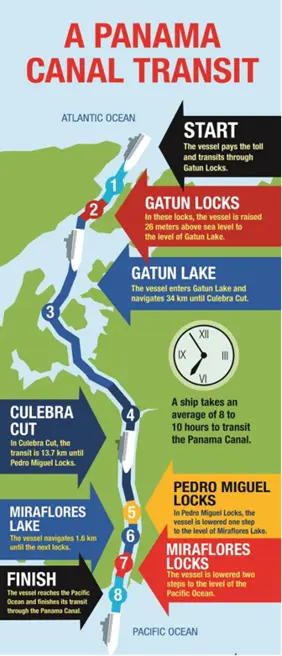
Impact of Climate Change on the Panama Canal
- Drought and Reduced Passage of Ships:
- October 2023 recorded 43% less rainfall than average, making it the driest October since the 1950s.
- Consequently, ship traffic dropped to 22 ships per day in December 2023, down from the usual 36 to 38, due to low water levels in Lake Gatun.
- Restriction on Size of Ships:
- Lower water levels limit the size of ships that can pass through the canal.
- Larger, heavier vessels face increased risk of running aground in shallower waters and require more water for lifting in the locks.
- Effect on Global Trade:
- As the Panama Canal handles 5% of global shipping, disruptions impact the worldwide supply chain, causing shipment delays, increased fuel use, and economic losses.
- Ships are now compelled to navigate around the southern tip of South America, extending travel distances.
Key Facts about the Panama Canal
- About the Panama Canal:
- The Panama Canal is an 82-kilometre artificial waterway in Panama connecting the Atlantic Ocean with the Pacific Ocean.
- It crosses the Isthmus of Panama, facilitating maritime trade and reducing the journey between New York and San Francisco by approximately 12,600 kilometres.
- The canal was first used by a ship on August 15, 1914.
- Functioning of the Panama Canal:
- The canal features a sophisticated system of locks and elevators to manage elevation changes between the Atlantic and Pacific Oceans.
- Since the Pacific is slightly higher, ships entering from the Atlantic are lifted through locks.
- The canal comprises 12 locks and utilises artificial lakes and channels to support its operation.
About Isthmus of Panama:
- Definition: A narrow land strip connecting two larger landmasses and separating two bodies of water, ideal for ports and canals.
- Geographical Significance: Links North and South America and separates the Pacific and Atlantic Oceans. Formed by the Caribbean tectonic plate pushing between the North and South American Plates, causing seafloor uplift.
- Note: A strait is a narrow waterway connecting two large bodies of water, like the Strait of Gibraltar between the Mediterranean Sea and the Atlantic Ocean. Straits are vital for maritime navigation.
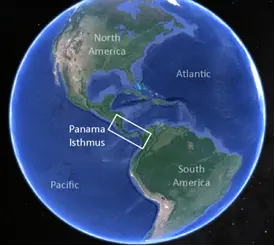
What are Other Important Canals Around the World?
- Suez Canal: Connecting the Gulf of Suez and the Mediterranean Sea, the Suez Canal separates Asia from Africa and provides the shortest maritime route between Europe and the Indian Ocean regions.
- Kiel Canal: These 98 km-long canals connect the Baltic Sea with the North Sea. Opened in 1895, it allows vessels to bypass the longer route around the Jutland Peninsula.
- Corinth Canal: The world’s narrowest canal, the Corinth Canal in Greece, connects the Corinthian Gulf of the Ionian Sea with the Saronic Gulf of the Aegean Sea.
- Kra Isthmus Canal (Thai Canal): A proposed canal that would connect the Andaman Sea to the Gulf of Thailand across the Kra Isthmus, providing a shortcut between India and China and avoiding the Strait of Malacca.
- Great Lakes Seaway Navigation System: This extensive navigation system in the United States connects the five Great Lakes, their channels, and the St. Lawrence River, flowing from west to east into the Atlantic Ocean.
|
UPSC Civil Services Examination, Previous Year Question (PYQ) Prelims Q:1 Between India and East Asia, the navigation-time and distance can be greatly reduced by which of the following? (2011)
Which of the statements given above is/are correct?
Ans: (b)
Mains Q:1 What is water stress? How and why does it differ regionally in India? (2019) Q:2 “The ideal solution of depleting groundwater resources in India is the water harvesting system”. How can it be made effective in urban areas? (2018) Q:3 In what way micro-watershed development projects help in water conservation in drought-prone and semi-arid regions of India? (2014) |
Increased Cancer Concerns
Why in the news?
- A recent study published in the journal Cancer projects a significant increase in global cancer cases and deaths among men by 2050.
- The study predicts an 84.3% rise in cancer cases and a 93.2% increase in cancer deaths compared to 2022 estimates.
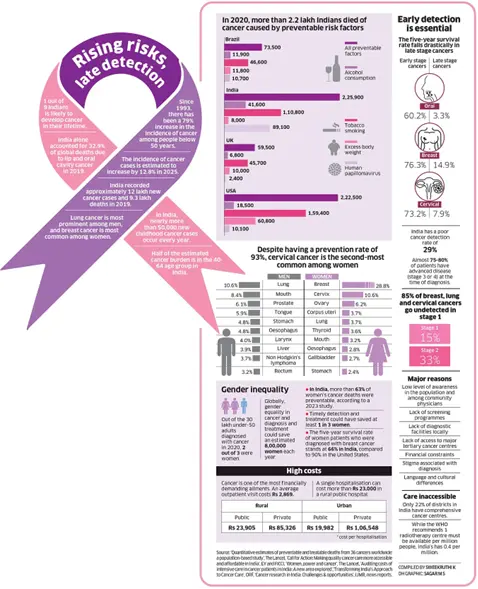
What are the Key Findings of the Study?
- Projected Increase in Cancer Cases and Deaths: By 2050, the number of cancer cases among men is expected to reach 19 million, with cancer deaths projected to total 10.5 million.
- Projection of Specific Cancer Types: Between 2022 and 2050:
- Mesothelioma cases are expected to rise by 105.5%.
- Prostate cancer deaths are projected to increase by 136.4%.
- Testicular cancer will see the smallest increases, with incidents rising by 22.7% and deaths by 40%.
- Dominance of Lung Cancer: Lung cancer is anticipated to remain the most prevalent and deadliest cancer type, with an over 87% increase in both incidence and mortality compared to 2022.
- Disparities Across Age and Regions: In 2022, about 10.3 million cancer cases and 5.4 million deaths occurred among men globally. Nearly two-thirds of these cases were in adults aged 65 and older.
- Impact of Human Development Index (HDI): From 2022 to 2050:
- Cancer cases are expected to increase by 50.2% in very high HDI countries and by 138.6% in low HDI countries.
- Cancer deaths are projected to rise by 63.9% in very high HDI countries and 141.6% in low HDI countries.
- High Mortality-to-Incidence Ratios: The study reports high mortality-to-incidence ratios, with older men at 61% and low HDI countries at 74%. Rare cancers, such as pancreatic cancer, have an even higher ratio of 91%, indicating poor survival outcomes.
What is the State of Cancer Prevalence in India?
- Cancer Statistics in India:
- In 2022, India reported 1,413,316 new cancer cases, with a higher incidence among women (722,138) compared to men (691,178).
- Breast cancer had the highest proportion, with 192,020 new cases, representing 13.6% of all patients and over 26% in women.
- Other Common Cancers:
- Following breast cancer, prevalent types include lip and oral cavity cancer (143,759 new cases, 10.2%), cervix and uterine cancer, lung cancer, and esophageal cancer.
- Regional and Global Impact:
- A WHO study, published in The Lancet Regional Health, found that India accounted for 32.9% of global deaths.
- 28.1% of new cases of lip and oral cavity cancer in 2019, largely due to the consumption of smokeless tobacco.
- Smokeless tobacco is responsible for 50% of the global oral cancer burden.
- Cervical Cancer:
- According to The Lancet Global Health 2023, India accounted for 23% of global cervical cancer deaths.
- The five-year survival rate for cervical cancer in India is 51.7%, lower than in high-income countries such as the United States.
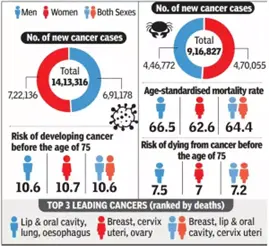
What are the Government Initiatives for Cancer Control in India?
- Customs Duty Exemption: The Union Budget 2024-25 exempted customs duty on three cancer drugs—Trastuzumab Deruxtecan, Osimertinib, and Durvalumab—to improve their accessibility and affordability.
- Cervical Cancer Vaccination Program: The Interim Budget 2024-25 emphasized the vaccination of girls aged 9-14 years as a preventive measure against cervical cancer.
- National Programme for Prevention and Control of Cancer, Diabetes, Cardiovascular Diseases and Stroke: This initiative aims to address major non-communicable diseases through prevention, control, and treatment strategies.
- National Cancer Grid: This program establishes a network of cancer care centres to ensure equitable access to cancer treatment and to promote research and clinical trials.
- National Cancer Awareness Day: Dedicated to raising awareness about cancer prevention, early detection, and treatment.
- HPV Vaccination: The government advocates the use of the Human Papillomavirus (HPV) vaccine to prevent cervical cancer.
- Ayushman Bharat - Health & Wellness Centres (AB-HWCs): These centres offer comprehensive primary health care, including cancer screening and preventive services.
What are the Key Highlights of the NITI Aayog Report on Early Cancer Detection in India?
- Cancer Screening Deficit: The NITI Aayog Report reveals a significant gap in cancer screening at Ayushman Bharat Health and Wellness Centres (HWCs), with fewer than 10% of these centres having conducted any screening for non-communicable diseases, including cancer.
- Screening Practices:
- Breast Cancer: Currently screened via self-examination, lacking systematic implementation.
- Cervical Cancer: Screening has not been fully adopted.
- Oral Cancer: Screening is performed on an ad hoc basis, depending on visible symptoms.
- Infrastructure and Resources: HWCs are reported to be lacking essential infrastructure, equipment, medicines, and diagnostic tests, affecting the effectiveness of cancer screening and diagnosis.
- Training and Awareness:
- There is a noted deficiency in training and monitoring for Auxiliary Nurses and Midwives (ANMs) concerning screening procedures.
- Furthermore, HWC staff have limited awareness regarding the need for annual screening for hypertension and diabetes.
|
UPSC Civil Services Examination, Previous Year Question (PYQ) Prelims Q1. ‘Mission Indradhanush’ launched by the Government of India pertains to (2016)
Ans: (a) Q:2 With reference to the treatment of cancerous tumours, a tool called cyberknife has been making the news. In this context, which one of the following statements is not correct? (2010)
Ans: (d)
Q:3 ‘RNA interference (RNAi)’ technology has gained popularity in the last few years. Why? (2019)
Select the correct answer using the code given below.
Ans: (a)
Mains: Q.1 What are the research and developmental achievements in applied biotechnology? How will these achievements help to uplift the poorer sections of the society? (2021) Q.2 What do you understand about nanotechnology and how is it helping in the health sector? (2020) |
Key Reforms Needed for India's Economic Growth
Why in the news?
- The IMF's Deputy Managing Director Gita Gopinath highlighted that India needs reforms in domestic resource mobilisation, infrastructure investment, and women's workforce participation to achieve developed economy status.
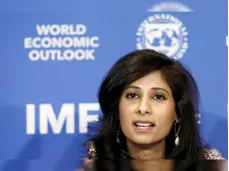
Current Economic Status of India:
- Development Goal: India aims to become a "developed nation" by 2047 under "Viksit Bharat 2047."
- Economic Ranking: India has surpassed the UK to become the fifth-largest global economy and may overtake Japan and Germany to reach third place by 2027, according to Morgan Stanley analysts.
- Economic Growth: India is the fastest-growing major economy with a 7% growth rate. Maintaining this momentum is crucial for increasing per capita incomes and achieving advanced economic status.
- Digital Reforms: India's digital governance reforms have significantly enhanced financial inclusion, streamlined public services, and reduced corruption.
- Economic Indicators:
- Nominal GDP: USD 3.54 trillion for FY24.
- Real GDP Growth: Estimated at 8.2% for FY24.
- World Bank Classification: Transitioned from low-income to lower-middle income in 2007, where it has remained.
Key Reforms Needed for India's Economic Growth:
- Simplification of GST: Streamlining the GST structure by reducing tax rates and broadening the base could increase revenue-to-GDP by 1 percentage point. This measure helps improve tax collection efficiency.
- Broaden Personal Income Tax Base: Expanding the personal income tax base, closing tax exemption loopholes, and enhancing property tax collection through technology are crucial for increasing fiscal resources.
- Targeted Subsidy Reforms: Effective targeting of subsidies, like the pilot fertiliser subsidies in Karnataka, can lead to significant cost savings and ensure benefits reach the intended recipients.
- Skilled Workforce and Education: Upgrading education quality and skill development is essential for economic advancement and competitiveness, especially compared to G20 countries.
- Women’s Labour Force Participation: Increasing women’s workforce participation from 35% and ensuring workplace safety are critical for India to achieve high-income status.
- Job Creation and Employment Policies: India must create 10 to 24 million jobs annually over the next decade, focusing on diverse sectors to provide broad-based employment opportunities.
- Land and Labour Reforms: Implementing land and labour reforms, including effective enforcement of the 2019 labour codes, is necessary for transitioning to a high-income economy.
- Ease of Doing Business: Improving the regulatory environment, judicial efficiency, and business procedures is essential for fostering economic activity.
- Openness to Trade and Lower Tariffs: Reducing average tariff rates and increasing openness to international trade will enhance global supply chain integration and India’s international position.
- Investment in Infrastructure: Continued investment in public and digital infrastructure is required to address existing gaps and sustain economic growth.
|
UPSC Civil Services Examination, Previous Year Questions (PYQs) Mains Q:1 Normally countries shift from agriculture to industry and then later to services, but India shifted directly from agriculture to services. What are the reasons for the huge growth of services vis-a-vis the industry in the country? Can India become a developed country without a strong industrial base? (2014) |
Miyawaki Method
Why in the news?
- The Chhattisgarh Forest Department recently conducted a Van Mahotsav programme in the Manendragarh-Chirmiri-Bharatpur (MCB) district, employing the Miyawaki method for sapling plantation.
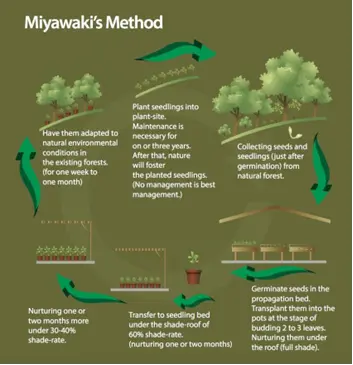
About the Miyawaki Method:
- Origin: Developed by Professor Akira Miyawaki, a Japanese botanist and plant ecology expert.
- Methodology:
- Involves planting 2-4 species of indigenous trees per square meter.
- Emphasises dense planting, leading to rapid growth as seedlings compete for sunlight.
- Only native species, naturally occurring under specific climate conditions, are selected for planting.
- Theory:
- Based on the concept of Potential Natural Vegetation (PNV), focusing on vegetation that would naturally occur without human interference.
- Outcomes:
- Trees achieve self-sustainability and reach full growth within three years.
- Miyawaki forests grow 10 times faster, are 30 times denser, and host 100 times more biodiversity than conventional forests.
- These forests require minimal maintenance after the initial 2-3 years and can be established on small plots of land, as little as 3 sq. m.
- Objectives:
- Enhancing biodiversity, carbon sequestration, increasing green cover, reducing air pollution, and preserving the water table.
- Significance:
- Miyawaki forests are effective for rapidly building climate resilience in urban areas.
- The method aligns with natural reforestation principles by utilising native species and mimicking natural forest regeneration processes.
Source: TOI
National Geoscience Awards
Why in the news?
- Recently, The President of India will confer the prestigious National Geoscience Awards - 2023 at the Rashtrapati Bhavan Cultural Centre, New Delhi.
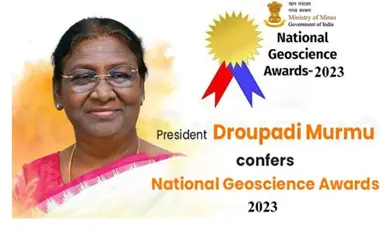
National Geoscience Awards
- About:
- The National Geoscience Awards is among the oldest and most prestigious national awards in the field of geosciences in India.
- Instituted by the Ministry of Mines, Government of India, in 1966, these awards were originally known as the National Mineral Awards until 2009.
- Objective:
- The primary objective of the National Geoscience Awards is to recognize and honour individuals and teams for their extraordinary achievements.
- Outstanding contributions in various domains of geosciences, including mineral discovery and exploration, mining technology and mineral beneficiation, and fundamental/applied geosciences.
- Eligibility:
- Any Indian citizen who has made a significant contribution to any field of geosciences is eligible to receive this award.
- Categories:
- The Ministry of Mines confers the National Geoscience Awards annually under three categories:
- National Geoscience Award for Lifetime Achievement
- National Geoscience Award
- National Young Geoscientist Award
- The Ministry of Mines confers the National Geoscience Awards annually under three categories:
- Significance:
- The National Geoscience Awards symbolise recognition and appreciation for exceptional individuals and organisations that have demonstrated excellence, dedication, and innovation in the realm of geosciences.
- Recent Update:
- For the year 2023, after detailed deliberations, the Ministry of Mines has selected 12 awards, including 09 individual awards and 03 team awards
Source: PIB
Hayflick limit
Why in the news?
- The recent death of Leonard Hayflick, a prominent biomedical researcher, has brought renewed attention to his groundbreaking discovery, the "Hayflick Limit," which fundamentally altered the understanding of ageing.
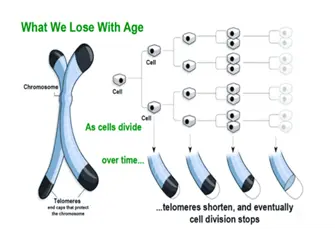
About the Hayflick Limit:
- Discovery:
- Leonard Hayflick, in the 1960s, discovered that somatic (non-reproductive) cells can divide only 40-60 times before ceasing division, a phenomenon known as cellular senescence.
- This cessation of cell division leads to the accumulation of senescent cells, a key factor in the ageing process.
- Implication:
- The Hayflick Limit suggests the existence of an intrinsic cellular clock in organisms, including humans, determining the maximum lifespan.
- For humans, this limit is estimated to be around 125 years.
- Comparison Across Species:
- Studies documented the Hayflick Limit in various species.
- For example, cells of Galapagos turtles, which live over 200 years, divide approximately 110 times before senescence.
- Whereas laboratory mice cells become senescent after just 15 divisions, correlating with their shorter lifespan.
Further Studies:
- Telomeres:
- In the 1970s, researchers discovered telomeres—repetitive DNA sequences at chromosome ends that protect them during cell division.
- With each division, telomeres shorten, signalling the end of cell division and contributing to ageing.
- While telomere shortening is linked to ageing, the relationship between telomere length and lifespan is complex. For instance, mice have longer telomeres than humans but live much shorter lives.
- Debate:
- Some researchers argue that telomere loss and the Hayflick Limit are not direct causes of ageing but are instead symptoms of the broader ageing process.
What about the Cell Division:
About:
- Cell division is a vital process where a parent cell divides to form daughter cells, essential for growth, repair, and reproduction in organisms.
Types:
- Mitosis:
- Occurs in somatic cells, producing two genetically identical daughter cells with the same chromosome number as the parent.
- It is crucial for growth, tissue repair, and asexual reproduction.
- Meiosis:
- Occurs in gametes, reducing the chromosome number by half, resulting in four non-identical daughter cells with 23 chromosomes each.
- This process ensures species' chromosome consistency and introduces genetic variation.
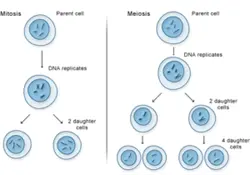
|
UPSC Civil Services Examination, Previous Year Question (PYQ) Prelims Q:1 Which one of the following statements best describes the role of B cells and T cells in the human body? (2022) (a) They protect the environmental allergens. body (b) They alleviate the body’s pain and inflammation. (c) They act as immunosuppressants in the body. (d) They protect the body from diseases caused by pathogens.
Ans: (d) |
Source: IE
Banni Grasslands
Why in the news?
- Recently, A new study conducted by researchers at Kachchh University assessed the suitability of different areas in Banni for sustainable grassland restoration, with ecological value being the primary criterion.

Highlights of the Study:
- Objective:
- The study by KSKV Kachchh University aimed to evaluate the suitability of different zones within the Banni grasslands for sustainable restoration, focusing on ecological value.
- Need for Restoration:
- The Banni grasslands, originally spanning around 3,800 sq. km, have reduced to approximately 2,600 sq. km, necessitating restoration efforts.
- Categories of Restoration Zones:
- The researchers classified the grasslands into five categories based on restoration suitability:
- Highly Suitable: 937 sq. km (36%)
- Suitable: 728 sq. km (28%)
- Moderately Suitable: 714 sq. km (27%)
- Marginally Suitable: 182 sq. km (7%)
- Not Suitable: 61 sq. km (2%)
- The researchers classified the grasslands into five categories based on restoration suitability:
- Restoration Potential:
- The "highly suitable" and "suitable" zones, comprising nearly two-thirds of the Banni grasslands, have high restoration potential if adequate water sources are provided.
About Banni Grasslands:
- Location:
- The Banni Grassland, situated in the Kutch district of Gujarat, is a salt-tolerant ecosystem covering approximately 3,847 sq. km.
- It is considered Asia’s largest grassland.
- Climate:
- The region experiences an arid to semi-arid climate, with scorching summers (temperatures above 45°C) and mild winters (12°C to 25°C).
- Annual rainfall ranges from 300-400 mm, predominantly during the monsoon season.
- Inhabitants:
- The grasslands are home to pastoral communities such as the Maldharis, who depend on livestock grazing (cattle, buffalo, and sheep) for their livelihood.
- Due to the arid conditions, agriculture is minimal, with some areas designated for salt production.
- Flora:
- The vegetation includes salt-tolerant grasses like Dichanthium, Sporobolus, and Cenchrus species, along with shrubs and trees like Acacia and the invasive Prosopis juliflora.
- Fauna:
- The grasslands support diverse wildlife, including the Indian wolf, hyena, chinkara, Great Indian Bustard, flamingos, and various raptors, reptiles, and invertebrates.
|
UPSC Civil Services Examination PYQ Prelims Q:1 The vegetation of Savannah consists of grassland with scattered small trees, but extensive areas have no trees. The forest development in such areas is generally kept in check by one or more or a combination of some conditions. Which of the following are such conditions?
Select the correct answer using the code given below.
Answer: C |
Source: TH
The Crisis of Youth Unemployment
Context:
- Recent data from the Periodic Labour Force Survey shows that youth face severe employment challenges, with a worker-population rate 40% lower and unemployment nearly three times higher than older age groups.
- This issue is compounded by a mismatch between educational qualifications and job opportunities, with highly educated individuals, especially women, facing the highest unemployment rates.
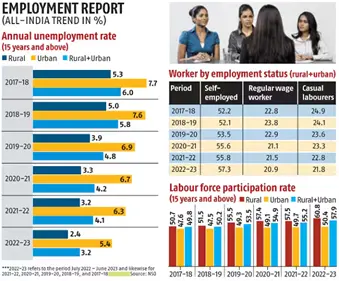
What is Unemployment?
- About:
- Unemployment occurs when individuals capable of working are actively seeking employment but cannot secure suitable jobs.
- Measurement: Unemployment is calculated using the formula:
- Unemployment Rate = (Number of Unemployed Workers / Total Labour Force) × 100
- Measurement: Unemployment is calculated using the formula:
- Here, the 'total labour force' includes both employed and unemployed individuals.
- Those neither employed nor actively seeking work, such as students, are not counted in the labour force.
- Unemployment occurs when individuals capable of working are actively seeking employment but cannot secure suitable jobs.
- Types of Unemployment:
- Structural Unemployment: Arises from mismatches between workers' skills and job requirements, reflecting systemic issues in the labour market.
- Cyclical Unemployment: Fluctuates with economic cycles, increasing during downturns and decreasing during expansions, illustrating the impact of macroeconomic conditions on job availability.
- Frictional Unemployment/Transitional Unemployment: Occurs as individuals transition between jobs, representing the temporary period spent searching for new employment.
- Underemployment: Involves individuals working in jobs that underutilize their skills or provide insufficient hours, reflecting economic inefficiency.
- Hidden Unemployment: Includes those not actively seeking work due to discouragement or other factors but who could enter the job market if conditions improve.
- Disguised Unemployment: Occurs when more workers are employed than needed, resulting in lower productivity per unit of labour.
- Causes of Unemployment:
- Population Size: High population increases competition in the job market, requiring effective economic and job creation strategies.
- Skills Mismatch: Discrepancies between workers' skills and job market needs highlight the need for improved education and vocational training.
- Informal Sector Dynamics: A large informal sector complicates unemployment tracking; formalising this sector can improve data accuracy.
- Policy Implementation Challenges: Even well-designed policies may face execution difficulties; alignment with real-world conditions is essential.
- Global Economic Factors: Global trade and geopolitical issues impact employment; policies should enhance economic resilience against external factors.
Current Trends of Youth Employment in India:
- Youth Unemployment Crisis:
- High Youth Unemployment Rates:
- Unemployment among youth (ages 15-29) remains substantially higher than the general population.
- In 2022, the unemployment rate for urban youth was 17.2%, compared to 10.6% in rural areas.
- Young women are particularly affected, with an unemployment rate of 21.6% compared to 15.8% for young men.
- Education Impact:
- Paradoxically, higher educational attainment among youth correlates with higher unemployment rates.
- For instance, in 2022, the unemployment rate was 18.4% for those with secondary education or higher, and 29.1% for graduates, while it was only 3.4% for illiterate individuals.
- NEET (Not in Employment, Education, or Training) Rates:
- A significant proportion of young people are neither employed, in education, nor in training.
- As of 2022, one in three youngsters fell into the NEET category. Women in the NEET category are nearly five times more than their male counterparts.
- High Youth Unemployment Rates:
- Gender Disparity:
- Work Participation Rates:
- Urban male youth have work participation rates more than three times higher than their female counterparts.
- Unemployment Rates for Women:
- Young women consistently face higher unemployment rates than young men, averaging around 50% higher.
- For example, 34.5% of female graduates were unemployed in 2022, compared to 26.4% of male graduates.
- Educated young women experience the highest unemployment rates, with 34.5% of female graduates unemployed.
- Work Participation Rates:

Regional Variations:
- Disparities Across States:
- High unemployment rates and low work participation are especially prevalent in states like Bihar, Uttar Pradesh, Jammu and Kashmir, Uttarakhand, Rajasthan, Odisha, Kerala, Himachal Pradesh, and Assam.
- Urbanisation Effect:
- Urbanised states like Goa and Kerala experience higher unemployment, while states with less urbanisation like Uttar Pradesh, Jharkhand, and Madhya Pradesh have lower unemployment rates.
- Urbanised states typically have smaller agrarian sectors and fewer informal job opportunities.


Potential of India’s Demographic Dividend:
- Youth Population:
- India boasts a significant demographic advantage, with over 50% of its population under the age of 25 and more than 65% below 35 years old.
- Workforce Growth:
- The working-age population in India is projected to grow by about 200 million people by 2030, enhancing the country's economic potential.
- Innovation and Entrepreneurship:
- According to the Global Entrepreneurship Monitor (GEM) 2023, India has a thriving startup ecosystem with over 70,000 startups, many led by young entrepreneurs.
- Startup Growth:
- Government initiatives such as Startup India have supported the establishment of over 80,000 startups since 2016, promoting a culture of innovation among the youth.
- Digital Economy:
- The IT and digital services sector contribute approximately 8% to India's GDP and employs over 4.5 million people.
- The expansion of digital platforms has created numerous job opportunities in IT, e-commerce, and digital content creation.
- Internet Penetration:
- As of 2024, India has over 800 million internet users, representing a vast digital market and significant job opportunities for tech-savvy youth.
- Global Competitiveness:
- India ranks 43rd out of 63 countries in the World Economic Forum’s Global Competitiveness Index 2023, highlighting the growing skills and potential of its workforce to enhance global competitiveness.
- IT Outsourcing:
- India continues to be a leading global hub for IT outsourcing, holding around 55% of the global market share in IT services, largely due to its skilled and youthful workforce.
Government Initiatives Related to Employment:
- National Youth Policy-2014: Aims to empower the youth by focusing on education, employment, skill development, and entrepreneurship, targeting young individuals aged 15-29 years.
- Pradhan Mantri Kaushal Vikas Yojana (PMKVY): Launched in 2015, this scheme has trained over 12 million youth in various skills to enhance their employability.
- National Skill Development Corporation (NSDC): Established in 2008, NSDC has facilitated the skilling of over 13 million people through various partnerships and initiatives.
- YUVA: Prime Minister’s Scheme for Mentoring Young Authors: Introduced in 2021, this program supports budding authors under the age of 30, providing mentorship and training to foster literary talent.
- Rashtriya Yuva Sashaktikaran Karyakram Scheme: This comprehensive scheme consolidates various youth development programs, aiming to enhance leadership, employability, and awareness among the youth.
- Support for Marginalised Individuals for Livelihood and Enterprise (SMILE): Launched in 2021, this initiative focuses on the economic empowerment of marginalised groups, including transgenders and beggars, through skill development and entrepreneurship opportunities.
- PM-DAKSH (Pradhan Mantri Dakshta Aur Kushalta Sampann Hitgrahi): Aims to provide skill development training to over 2.7 lakh SC, ST, OBC, and economically weaker section beneficiaries from 2020 to 2025.
- Mahatma Gandhi National Rural Employment Guarantee Act (MGNREGA): Since its inception in 2006, MGNREGA has provided over 2.5 billion person-days of work annually, ensuring livelihood security through guaranteed wage employment.
- Start-Up India Scheme: Launched in 2016, this initiative has recognized over 90,000 startups, fostering innovation and entrepreneurship across the country.
- Rozgar Mela: A nationwide employment drive aimed at creating 10 lakh jobs by 2024, focusing on enhancing job opportunities in various sectors.
- Indira Gandhi Urban Employment Guarantee Scheme (Rajasthan): Launched in 2022, this scheme guarantees 100 days of employment to urban households, providing social security to the urban poor.
- Direct Benefit Transfer (DBT) Scheme: DBT has streamlined the disbursement of subsidies and welfare benefits directly to beneficiaries' bank accounts, reducing leakage and improving efficiency.
- Pradhan Mantri Mudra Yojana (PMMY): Since its launch in 2015, PMMY has provided over 35 crore loans, amounting to more than ₹18 lakh crore, to micro and small enterprises, promoting entrepreneurship and self-employment.
Conclusion:
With over 65% of its population under 35, India holds the world's largest youth demographic, which is set to grow in the coming decade. Harnessing this demographic dividend is crucial for nation-building. To achieve this, the economy must support the expanding labour force, and the youth must be equipped with the necessary education, skills, health awareness, and other enablers to contribute productively to the nation's growth.
|
UPSC Civil Services Examination Previous Year Question (PYQ) Prelims Q:1 Pradhan Mantri MUDRA Yojana is aimed at (2016)
Ans: (a)
Q:2 Disguised unemployment generally means (2013)
Ans: (c)
Mains Q:1 Most of the unemployment in India is structural in nature. Examine the methodology adopted to compute unemployment in the country and suggest improvements. (2023) Q:2 The nature of economic growth in India in recent times is often described as jobless growth. Do you agree with this view? Give arguments in favour of your answer. (2015) |
Source: BS
Share the article
Edukemy’s Current Affairs Quiz is published with multiple choice questions for UPSC exams
MCQ
Get Latest Updates on Offers, Event dates, and free Mentorship sessions.

Get in touch with our Expert Academic Counsellors 👋
FAQs
UPSC Daily Current Affairs focuses on learning current events on a daily basis. An aspirant needs to study regular and updated information about current events, news, and relevant topics that are important for UPSC aspirants. It covers national and international affairs, government policies, socio-economic issues, science and technology advancements, and more.
UPSC Daily Current Affairs provides aspirants with a concise and comprehensive overview of the latest happenings and developments across various fields. It helps aspirants stay updated with current affairs and provides them with valuable insights and analysis, which are essential for answering questions in the UPSC examinations. It enhances their knowledge, analytical skills, and ability to connect current affairs with the UPSC syllabus.
UPSC Daily Current Affairs covers a wide range of topics, including politics, economics, science and technology, environment, social issues, governance, international relations, and more. It offers news summaries, in-depth analyses, editorials, opinion pieces, and relevant study materials. It also provides practice questions and quizzes to help aspirants test their understanding of current affairs.
Edukemy's UPSC Daily Current Affairs can be accessed through:
- UPSC Daily Current Affairs can be accessed through Current Affairs tab at the top of the Main Page of Edukemy.
- Edukemy Mobile app: The Daily Current Affairs can also be access through Edukemy Mobile App.
- Social media: Follow Edukemy’s official social media accounts or pages that provide UPSC Daily Current Affairs updates, including Facebook, Twitter, or Telegram channels.


